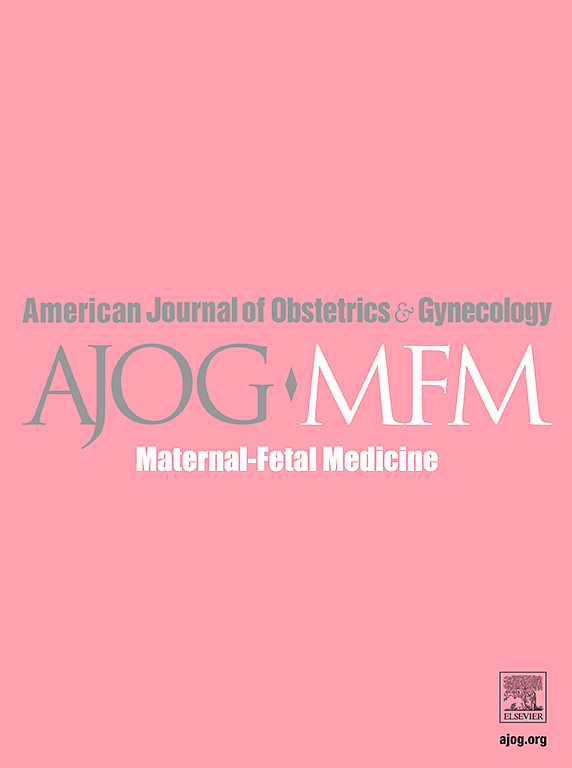IF 3.8
2区 医学
Q1 OBSTETRICS & GYNECOLOGY
American Journal of Obstetrics & Gynecology Mfm
Pub Date : 2025-01-25
DOI:10.1016/j.ajogmf.2025.101614
引用次数: 0
摘要
背景:子痫前期是妊娠期主要的高血压疾病,可导致严重的并发症,尤其是在产后的前两周。在产后期间,血压水平仍然很高,通常会增加到比怀孕期间更高的水平。速尿是一种速效利尿剂,可减少血管内容量超载,可能是加速血压水平正常化的另一种选择。目的:评价呋塞米与安慰剂对重度子痫前期妇女产后血压控制的效果。研究设计:在一项三盲安慰剂对照随机临床试验中,接受硫酸镁治疗的产后新发子痫前期患者,伴有严重特征或在妊娠期诊断为子痫且利尿充足,随机接受呋塞米(40 mg/天口服5天)或安慰剂。主要结局是平均血压水平。次要结局是:严重高血压发作的频率、持续需要抗高血压药物、用于控制血压的抗高血压药物的数量、住院时间、不良反应和产妇并发症。根据速尿组平均收缩压142±12mmHg和安慰剂组153±19mmHg的估计差异,估计样本量为120例,每组60例。结果:2014年6月20日至11月30日期间,筛查了271名妇女,其中120名随机分为速尿组或安慰剂组,其中118名纳入最终分析(速尿组58名,安慰剂组60名)。两组的大多数特征相似。结论:与安慰剂相比,产后子痫前期患者口服40 mg/天呋塞米可降低第1、5天的平均每日收缩压和第1、2、5天的平均每日舒张压及血压控制所需时间。本文章由计算机程序翻译,如有差异,请以英文原文为准。
Postpartum furosemide for accelerating recovery in patients with preeclampsia: a randomized placebo-controlled trial
BACKGROUND
Preeclampsia is a major hypertensive disorder of pregnancy that may lead to severe complications, particularly in the first 2 weeks of the postpartum period. Blood pressure during the postpartum period remains high and often increases to levels higher than those observed during pregnancy. Furosemide, a fast-acting diuretic, reduces intravascular volume overload and may represent an alternative to accelerate the normalization of blood pressure levels.
OBJECTIVE
This study aimed to evaluate the effectiveness of furosemide compared with a placebo for blood pressure control in the postpartum period in women with severe preeclampsia.
STUDY DESIGN
In a triple-masked placebo-controlled randomized clinical trial, postpartum women with de novo preeclampsia with severe features or eclampsia diagnosed during pregnancy and adequate diuresis who had received magnesium sulfate were randomized to receive furosemide (40 mg/d orally for 5 days) or a placebo. The primary outcome was mean blood pressure. The secondary outcomes were frequency of severe hypertensive episodes, continued need for antihypertensives, number of antihypertensives used to control blood pressure, length of hospital stay, adverse effects, and maternal complications. A sample size of 120 patients was estimated, 60 in each arm of the study, based on the estimated difference between the mean systolic pressure of 142±12 mm Hg for the furosemide group and 153±19 mm Hg for the placebo group.
RESULTS
Between June 20, 2014, and November 30, 2014, 271 women were screened, and 120 were randomized to the furosemide or placebo groups, of which 118 were included in the final analysis (58 in the furosemide group and 60 in the placebo group). Most characteristics were similar between the groups. The mean daily systolic and diastolic pressures were lower in the furosemide group (P<.001), and there were fewer episodes of severe hypertension on the second (P=.04) and fifth (P=.04) days of the postpartum period. In addition, a shorter time was required until blood pressure was controlled (P=.01) in the furosemide group.
CONCLUSION
Compared with placebo, 40 mg/d of oral furosemide in patients with preeclampsia reduced the mean daily systolic blood pressure in the first and fifth days of the postpartum period and mean daily diastolic blood pressure in the first, second, and fifth days of the postpartum period and the time required for blood pressure control.
求助全文
通过发布文献求助,成功后即可免费获取论文全文。
去求助
来源期刊

American Journal of Obstetrics & Gynecology Mfm
Medicine-Medicine (all)
CiteScore
7.40
自引率
3.20%
发文量
254
审稿时长
40 days
期刊介绍:
The American Journal of Obstetrics and Gynecology (AJOG) is a highly esteemed publication with two companion titles. One of these is the American Journal of Obstetrics and Gynecology Maternal-Fetal Medicine (AJOG MFM), which is dedicated to the latest research in the field of maternal-fetal medicine, specifically concerning high-risk pregnancies. The journal encompasses a wide range of topics, including:
Maternal Complications: It addresses significant studies that have the potential to change clinical practice regarding complications faced by pregnant women.
Fetal Complications: The journal covers prenatal diagnosis, ultrasound, and genetic issues related to the fetus, providing insights into the management and care of fetal health.
Prenatal Care: It discusses the best practices in prenatal care to ensure the health and well-being of both the mother and the unborn child.
Intrapartum Care: It provides guidance on the care provided during the childbirth process, which is critical for the safety of both mother and baby.
Postpartum Issues: The journal also tackles issues that arise after childbirth, focusing on the postpartum period and its implications for maternal health. AJOG MFM serves as a reliable forum for peer-reviewed research, with a preference for randomized trials and meta-analyses. The goal is to equip researchers and clinicians with the most current information and evidence-based strategies to effectively manage high-risk pregnancies and to provide the best possible care for mothers and their unborn children.
 求助内容:
求助内容: 应助结果提醒方式:
应助结果提醒方式:


